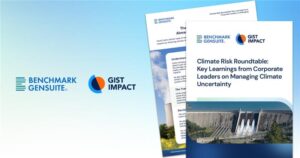PFAS (per- and polyfluoroalkyl substances) have become a significant environmental and health concern. These synthetic chemicals, found in everything from fast food packaging to paints, are known for their ability to persist in the environment, earning them the nickname “forever chemicals.” As regulations tighten in the U.S. and around the world, industries are being forced to rethink how they manage PFAS risks.
Recently, Benchmark Gensuite hosted an innovation group meeting to discuss how industrial hygiene teams are navigating new PFAS regulations. Key customers of Benchmark’s IH application joined the conversation to share how they’re approaching this challenge. Ankit Sharma, Associate Director at International Safety Systems and Sandra Neale, EHS Executive Leader at GE Vernova provided valuable insights into their organizations’ approaches to PFAS risk assessments.
Ankit Sharma started by explaining how different regions are updating their PFAS regulations. “There have been many recent updates to PFAS regulations worldwide. For example, the EU has proposed restrictions that could lead to a near-total ban on PFAS, with few exceptions, as early as 2026.” He further emphasized that despite the increased attention on water contamination, industrial hygiene must also focus on potential employee exposures to PFAS through air and skin contact.
Sandra Neale shared GE Vernova’s strategy for managing PFAS. Her team is using a qualitative risk assessment, evaluating the risks of PFAS in their industrial processes. “We’re focusing on PFAS processes that we can’t eliminate right now. If our industrial hygiene risk assessment shows the risk is too high, we immediately implement measures to control those exposures.” This approach ensures that employees are protected while long-term engineering controls are developed.
Challenges and Considerations for Industrial Hygiene PFAS Risk Assessments
The group identified several challenges that companies face when managing PFAS in the workplace. One major hurdle is the lack of clear occupational exposure limits (OELs) for many PFAS compounds. Ankit Sharma noted, “With limited information on sampling methods and exposure limits, how do we begin? We need to start by going back to basics and focusing on the first step: conducting an industrial hygiene risk assessment.”
Sharma emphasized the importance of a cradle to grave approach. Experienced industrial hygienists can doing a thorough evaluation of processes, from the receipt of materials in the warehouse all the way to dispatch and any associated ancillary processes in between. Due to the widespread use of PFAs and the availability of these chemicals in pretty much all different type of products, it is going to be an extensive and detailed process. “When we have identified activities with potential PFAs used, then we integrate our basic industrial hygiene principles, which is trying to understand how the material is handled, what kind of controls are available, and what is the duration and frequency of exposures?”
“There’s an opportunity to collaborate with environmental and product stewardship teams to identify where PFAS chemicals are being handled, produced, or likely present,” said Sharma, emphasizing the need for a cross-functional approach in managing these chemicals.
One key issue discussed is the difficulty in detecting PFAS. While the EPA has developed water sampling methods, air sampling techniques for PFAS are still in development. Participants also raised concerns about PFAS exposure through skin contact. This highlighted the need for better understanding and guidance on decontamination methods.
Sandra Neale acknowledged the complexities, saying, “There are many unknowns in this area right now … but there are IH analytical methods available for validating both PFAS assessments and engineering controls.”
How Benchmark Gensuite’s Tools Can Help
Benchmark Gensuite’s industrial hygiene solutions offer several ways to help companies manage PFAS risks. One powerful feature is the Industrial Hygiene Risk Assessment Tool. This tool allows companies to assess potential PFAS exposures by evaluating tasks, assessing risks and exposures, and comparing against occupational exposure limits. It’s a critical step in understanding how PFAS is handled throughout a company’s operations, from product use to waste management.
The IH Awareness Card is another valuable tool that simplifies communication between industrial hygiene teams and employees. It provides a clear, easy-to-read, and printable summary of potential risks, exposure limits, GHS symbols, and precautionary and protective measures, such as any engineering controls in place or whether training or personal protective equipment (PPE) is required to work with the material. Sandra Neale praised its effectiveness, saying, “ I love that it’s boiled down to bring in those GHS pieces from SDS. It’s an industrial hygiene summary and protocol to communicate with employees.”
As PFAS regulations continue to evolve, ensuring your company stays compliant and protects its workforce is more important than ever. Benchmark Gensuite’s innovative tools can help you take control of PFAS risks in your operations. Don’t wait until regulations catch up, equip your team with the solutions they need to stay ahead. Contact us today to learn how our digital platform can support your industrial hygiene and PFAS management efforts.



